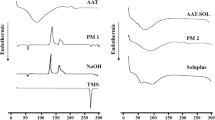Abstract
Free-flowing proniosomal powders of acemetacin (AC) were prepared using the slurry method and maltodextrin as carrier. Positively charged proniosomes composed of 70:20:10 of Span 60/cholesterol (Chol)/stearylamine (SA), respectively, were successively compressed into tablets using direct compression method. The tablets were characterized for weight variability, friability, hardness, drug content uniformity, and dissolution properties. The in vivo evaluation of the prepared proniosomes (powder or tablet forms) after oral administration was investigated by the determination of AC and its active metabolite indomethacin (IND) in the blood of albino rabbits. Results indicated that the increase of Chol from 10% to 20% markedly reduced the efflux of the drug. Further Chol addition from 30% to 50% led to increased AC release rates. The proniosome tablets of AC showed greater hardness and disintegration time and less friability than AC plain tablets. The dissolution of proniosomal tablets indicated a lower drug release percentage compared to powdered proniosomes and AC plain tablets. The mean pharmacokinetic parameters of AC and IND from different formulations indicated increased t 1/2 and area under the curve (AUC) of both AC and IND for proniosomal tablets compared with both proniosomal powders and AC plain tablets. This study suggested the formulation of AC proniosomal powder into tablets to control and extend its pharmacologic effects.






Similar content being viewed by others
REFERENCES
Storm G, Crommelin DJA. Liposomes: quo vadis? PSTT. 1998;1(1):19–31.
Dua JS, Rana AC, Bhandari AK. Liposomes: methods of preparation and application. Int J Pharm Sci Res. 2012;3(2):14–20.
Ulrich AS. Biophysical aspects of using liposomes as delivery vehicles. Biosci Rep. 2002;22(2):129–50.
Smola M, Vandamme T, Sokolowski A. Nanocarriers as pulmonary drug delivery systems to treat and to diagnose respiratory and non-respiratory diseases. Int J Nanomedicine. 2008;3(1):1–19.
Kumar D, Sharma D, Singh G, Singh M, Rathore MS. Lipoidal soft hybrid biocarriers of supramolecular construction for drug delivery. ISRN Pharm. 2012;2012:1–14.
Hu C, Rhodes DG. Proniosomes: a novel drug carrier preparation. Int J Pharm. 1999;185:23–35.
Blazek-Welsh AI, Rhodes DG. SEM imaging predicts quality of niosomes from maltodextrin-based proniosomes. Pharm Res. 2001;18:656–61.
Solanki A, Parikh J, Parikh R. Preparation, characterization, optimization, and stability studies of aceclofenac proniosomes. Int J Pharm Res. 2008;7(4):237–46.
Raja K, Jestin PU, Athul PV, Tamizharasi S, Sivakumar T. Formulation and evaluation of maltodextrin based proniosomal drug delivery system containing anti-diabetic (Glipizide) drug. Int J Pharm Tech Res. 2011;3(1):471–7.
Carter SJ. In: Copper J, Gunn S, editors. Tutorial pharmacy. 6th ed. New Delhi: CBS Publishers and Distributors; 1986. p. 211–33.
Basak SC, Kumar KS, Ramalingam M. Design and release characteristics of sustained release tablet containing metformin HCL. Braz J Pharm Sci. 2008;44:477–83.
Marwa HA, Omaima AS, Hanaa AE, Hanan ME. Optimizing proniosomes for controlled release of ketoprofen using Box-Behnken experimental design. Int J Pharm Sci Res. 2011;2(8):2195–205.
Mokhtar M, Sammour OA, Hammad MA, Megrab NA. Effect of some formulation parameters on flurbiprofen encapsulation and release rates of niosomes prepared from proniosomes. Int J Pharm. 2008;361:104–11.
Goud BA, Raju G, Rambhau D. Formulation and evaluation of megestrol proniosomal systems. IJPBS. 2012;2(2):67–76.
Velmurugan S, Deepa RD, Nagarjuna RG. Formulation and evaluation of etoricoxib orodispersible tablets. Int J Pharm Tech Res. 2013;5(2):475–85.
Pawar PS, Saleem MA. Formulation and evaluation of oral colon targeted tablet of budesonide. Pharm Lett. 2013;5(3):1–12.
Chávez-Piña AE, Favari L, Castañeda-Hernández G. Pharmacokinetics of acemetacin and its active metabolite indomethacin in rats during acute hepatic damage and liver regeneration. Ann Hepatol. 2009;8(2):141–7.
Parthibarajan R, Rubinareichal R, Loganathan S. Formulation and evaluation of methotrexate proniosomal powder. Int J Pharm Pharm Sci. 2012;4(11):175–8.
Sankar V, Ruckmani K, Durga S, Jailani S. Proniosomes as drug carriers. Pak J Pharm Sci. 2010;23(1):103–7.
Mokhtar MI, Salma AT, Mahdi M. Liposomal diltiazem HCl as ocular drug delivery system for glaucoma. Drug Dev Ind Pharm. 2013. doi:10.3109/03639045.2013.783589.
Marwa HA, Omaima AS, Hanaa AE, Mohammed EA. Design and development of piroxicam-entrapped niosomes as an oral drug delivery system. Int J Adv Pharm Res. 2013;4(6):1873–86.
El-Ridy MS, Badawi AA, Safar MM, Mohsen AM. Niosomes as a novel pharmaceutical formulation encapsulating the hepatoprotective drug silymarin. Int J Pharm Pharm Sci. 2012;4(1):549–59.
Betageri GV. Liposomal encapsulation and stability of dideoxyinosine triphosphate. Drug Dev Ind Pharm. 1993;19:531–9.
Sammour OA, Al-Zuhair HH, El-Sayed MI. Inhibitory effect of liposome-encapsulated piroxicam on inflammation and gastric mucosal damage. Pharm Ind. 1998;60(12):1084–7.
Omaima NE, Ahmed HH. Preparation and evaluation of acetazolamide liposomes as an ocular delivery system. Int J Pharm. 1997;158:121–5.
Guinedi AS, Mortada ND, Mansour S, Hathout RM. Preparation and evaluation of reverse-phase evaporation and multilamellar niosomes as ophthalmic carriers of acetazolamide. Int J Pharm. 2005;306:71–82.
Abdallah M, Sammour O, EL-Ghamry H, Abu-Selem M. Preparation and in-vitro evaluation of diclofenac sodium niosomal formulations. Int J Pharm Sci Res. 2013;4(5):1757–65.
El-Samaligy MS, Afifi NN, Mahmoud EA. Increasing system: preparation and experimental design investigation. Int J Pharm. 2006;308:140–8.
Author information
Authors and Affiliations
Corresponding author
Rights and permissions
About this article
Cite this article
Shehata, T.M., Abdallah, M.H. & Ibrahim, M.M. Proniosomal Oral Tablets for Controlled Delivery and Enhanced Pharmacokinetic Properties of Acemetacin. AAPS PharmSciTech 16, 375–383 (2015). https://doi.org/10.1208/s12249-014-0233-5
Received:
Accepted:
Published:
Issue Date:
DOI: https://doi.org/10.1208/s12249-014-0233-5




